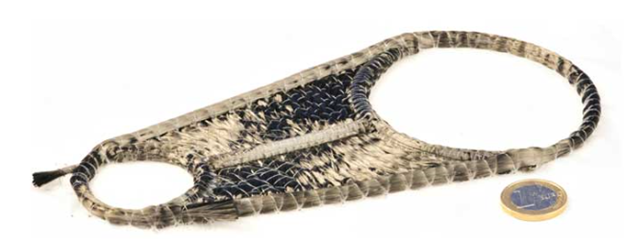Optimization four: tunable localized thickness
Section outline
-
Tailored fiber placement (TFP) in carbon fiber composites offers a significant advantage through the optimization of tunable thickness across a given area. Unlike traditional laminate designs, which assume a uniform thickness, TFP allows for variable thicknesses, enabling enhanced structural performance. This approach, when paired with carefully designed molding and fixtures, allows carbon fiber preforms to achieve localized thickness variations across complex geometries. In classical beam theory, the moment of inertia \( I \) for a rectangular beam is calculated by:
\[ I = \frac{b \cdot h^3}{12} \]
Here, \( h \) represents the height of the material and has a cubic influence on the moment of inertia, whereas \( b \) is the base length. This indicates that increasing the thickness in specific areas significantly enhances the material's resistance to bending. Consequently, tailored fiber placement can optimize material usage by concentrating thickness where it is most needed, achieving improved mechanical properties with less material compared to traditional composite processes.
Advanced machinery, such as those offered by ZSK, can lay fibers with a thickness of up to 8 mm, equivalent to approximately eight layers of 50K carbon fiber roving. This thickness can be uniformly applied across the preform or strategically placed in key structural areas to provide additional mechanical support where necessary.

In the example above, thickness is strategically increased around the perimeter and center of the component. This additional thickness enhances the part's ability to withstand bending moments, while reducing material costs by avoiding unnecessary reinforcement in areas that do not require it. Furthermore, the curvilinear placement of fibers around holes minimizes crack propagation, a common issue in orthogonal woven sheet laminate designs, and reduces waste and post-processing requirements.
Further Reading & Resources
For more in-depth information, consider exploring the following resources:
- ZSK Technical Embroidery Systems - Learn more about advanced embroidery and fiber placement machinery.
- ScienceDirect: Tailored Fiber Placement - A detailed study on the applications and benefits of TFP in composite manufacturing.
- Composites World: Tailored Fiber Placement - An article discussing the latest innovations and trends in TFP.
